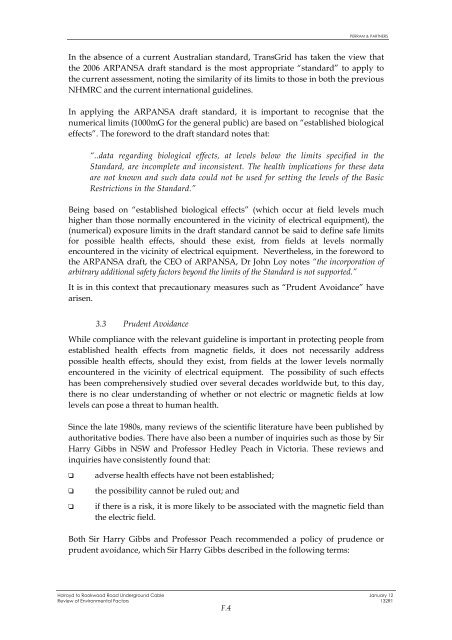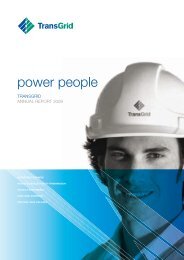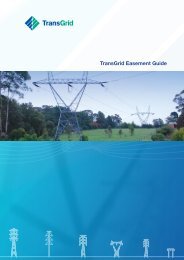Holroyd to Rookwood Road cable REF - TransGrid
Holroyd to Rookwood Road cable REF - TransGrid
Holroyd to Rookwood Road cable REF - TransGrid
You also want an ePaper? Increase the reach of your titles
YUMPU automatically turns print PDFs into web optimized ePapers that Google loves.
PERRAM & PARTNERS<br />
In the absence of a current Australian standard, <strong>TransGrid</strong> has taken the view that<br />
the 2006 ARPANSA draft standard is the most appropriate “standard” <strong>to</strong> apply <strong>to</strong><br />
the current assessment, noting the similarity of its limits <strong>to</strong> those in both the previous<br />
NHMRC and the current international guidelines.<br />
In applying the ARPANSA draft standard, it is important <strong>to</strong> recognise that the<br />
numerical limits (1000mG for the general public) are based on “established biological<br />
effects”. The foreword <strong>to</strong> the draft standard notes that:<br />
“..data regarding biological effects, at levels below the limits specified in the<br />
Standard, are incomplete and inconsistent. The health implications for these data<br />
are not known and such data could not be used for setting the levels of the Basic<br />
Restrictions in the Standard.”<br />
Being based on “established biological effects” (which occur at field levels much<br />
higher than those normally encountered in the vicinity of electrical equipment), the<br />
(numerical) exposure limits in the draft standard cannot be said <strong>to</strong> define safe limits<br />
for possible health effects, should these exist, from fields at levels normally<br />
encountered in the vicinity of electrical equipment. Nevertheless, in the foreword <strong>to</strong><br />
the ARPANSA draft, the CEO of ARPANSA, Dr John Loy notes “the incorporation of<br />
arbitrary additional safety fac<strong>to</strong>rs beyond the limits of the Standard is not supported.”<br />
It is in this context that precautionary measures such as “Prudent Avoidance” have<br />
arisen.<br />
3.3 Prudent Avoidance<br />
While compliance with the relevant guideline is important in protecting people from<br />
established health effects from magnetic fields, it does not necessarily address<br />
possible health effects, should they exist, from fields at the lower levels normally<br />
encountered in the vicinity of electrical equipment. The possibility of such effects<br />
has been comprehensively studied over several decades worldwide but, <strong>to</strong> this day,<br />
there is no clear understanding of whether or not electric or magnetic fields at low<br />
levels can pose a threat <strong>to</strong> human health.<br />
Since the late 1980s, many reviews of the scientific literature have been published by<br />
authoritative bodies. There have also been a number of inquiries such as those by Sir<br />
Harry Gibbs in NSW and Professor Hedley Peach in Vic<strong>to</strong>ria. These reviews and<br />
inquiries have consistently found that:<br />
adverse health effects have not been established;<br />
the possibility cannot be ruled out; and<br />
if there is a risk, it is more likely <strong>to</strong> be associated with the magnetic field than<br />
the electric field.<br />
Both Sir Harry Gibbs and Professor Peach recommended a policy of prudence or<br />
prudent avoidance, which Sir Harry Gibbs described in the following terms:<br />
<strong>Holroyd</strong> <strong>to</strong> <strong>Rookwood</strong> <strong>Road</strong> Underground Cable January 12<br />
Review of Environmental Fac<strong>to</strong>rs 132R1<br />
F.4




